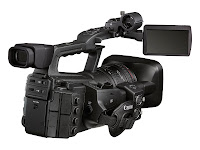Panasonic's new
AG-HPX370/AG-HPX371 P2 HD camcorder is an update to its very successful
HPX300/HPX301. The shoulder-mounted model retains the same reasonable price (under 10,000 Euros/ $11,700 list), but uses newly-developed 1/3-inch, full-HD 2.2 megapixel
Ultra Luminance Technology 3-MOS sensors.
The new sensors are claimed to rival "the image quality and sensitivity of half-inch imagers" offering "marked improvements in sensitivity, measured at F10" thanks to ULT. These levels of sensitivity and image quality have been achieved with a new high-sensitivity photodiode and low-noise pixel transistor, both based on low-noise analogue process technology. The same levels of sensitivity and image production that characterize the interlace mode are now possible in progressive mode courtesy of Progressive Advanced Processing, a 3D adaptive processing technology.
The HPX370/HPX371 also features flash band detection and compensation software that eliminates the "flash band" effect that can occur with MOS-based imagers (a by product of rolling shutter).
It also has a 20-bit Digital Signal Processor, and records full 1920x1080 using 10-bit, 4:2:2, independent-frame AVC-Intra recording (to two P2 card slots).

In AVC-Intra 100 and 50, it records in 1080 at 59.94i, 29.97p, 23.98p (native 24p/30p), 50i and 25p (native) and in 720p with variable frames in 23.98p (native), 29.97p (native), 59.94p, 50p and 25p (native). It also supports 100Mbps DVCPRO HD and standard definition recording in DVCPRO50, DVCPRO and DV.
The kit lens is a Fujinon 17x HD zoom but it can take any 1/3-inch lens or, via an adapter, 2/3-inch lenses. The camera has Chromatic Aberration Compensation, scan reverse for use with film lenses, a Dynamic Range Stretch to help compensate for wide variations in lighting, a waveform monitor and vector scope display, and two focus assist functions – picture expansion and a focus bar. It also has a one-clip REC function that records up to 99 consecutive cuts as a single clip, to make nonlinear editing simpler.
It has two HD-SDI outputs, FireWire, USB 2.0, time code input/output, and can be used as a studio camera. with the optional AJ-RC10G Remote Control Unit and compatible studio remote control systems. Panasonic offers a customized studio configuration that includes the AG-BS300 base station, AG-EC4 extension control unit and AG-CA300 remote control camera adapter.
It weighs about 3.6kg and power consumption is 19 Watts.
[[UPDATE: Panasonic has released 18 new, free, downloadable scene styles for the HPX370]]
AVCCAM HD + SD
Panasonic's new 3megapixel, 3MOS
HMC80/HMC81 camcorder is the first AVCCAM model with both HD (up to 24Mbps AVCHD) and SD (DV 25Mbps) recording. It can also take 10.6MP still images and store them as standard JPEGs on the SDHC card.
The shoulder-mounted camera includes: user-assignable manual focus ring functions (Focus/Iris/Zoom); time code/UB recording; time/date stamp; and two wired remote control terminals (for zoom, focus, iris, REC start/stop controls). It has a 12x zoom lens with a surprisingly poor 40.8mm (35mm lens equivalent) wide-angle setting. It has an Optical Image Stabilizer, Dynamic Range Stretch and a Cine-Like Gamma mode to give recordings a more film-like look – it can record 1080/24p (as well as 25/30p, 50/60i and 720 24p, 25/30p. 50/60p).
Outputs include: HDMI (AVCHD only), USB 2.0, composite (BNC), analogue component (BNC x 3),and FireWire (DV). For audio it has a built-in stereo microphone, a 3.5mm mini jack, and two XLR inputs. It will be available in September.
3D to order
Its new
twin-lens HD 3D Camcorder, the
AG-3DA1, is now available for pre-order, promising September delivery, and has already garnered a lot of interest, showing a working prototype at NAB. "As a single rig camera offering recording direct to an SD media card, it vastly simplifies 3D content capture, which will help to bring down remaining barriers to 3D filming," said Carmen Mendoza, Panasonic’s Broadcast Marketing GM.
It records AVCHD 1080 60/50i, 30/25p and 24p (native), plus 720 50/60p, weighs less than 3kg, has dual HD-SDI out (so you can bypass the AVCHD and record on a Ki-Pro or nanoFlash), HDMI (version 1.4), two XLR connectors, built-in stereo microphone and twin-lens camera remotes. It will cost 16,800 Euros.
Related post:
Panasonic 3D camcorder gets AVCHD
By David Fox
 The Cambio has an extendable centre column (up to 142cm) that is usually used as the trolley bag handle (also useful for those of us that find most trolley bag handles too short). You can screw a tripod head into the handle (using a 75mm bowl), and it will support cameras weighing up to 4.5kg, including the head (so will take most budget camcorders – up to a JVC HM700 – and any HD DSLRs)
The Cambio has an extendable centre column (up to 142cm) that is usually used as the trolley bag handle (also useful for those of us that find most trolley bag handles too short). You can screw a tripod head into the handle (using a 75mm bowl), and it will support cameras weighing up to 4.5kg, including the head (so will take most budget camcorders – up to a JVC HM700 – and any HD DSLRs) The Cambio will cost $699 for the bag, or $799 for a usable system including an easily attached lightweight micro-fluid head. For the same money, you could get a pretty good, lightweight, compact three-stage tripod and a separate trolley bag, and have greater flexibility. However, the Cambio can be taken as carry-on luggage, and with the ever greater restrictions being placed on airline baggage, that could be the deciding factor.
The Cambio will cost $699 for the bag, or $799 for a usable system including an easily attached lightweight micro-fluid head. For the same money, you could get a pretty good, lightweight, compact three-stage tripod and a separate trolley bag, and have greater flexibility. However, the Cambio can be taken as carry-on luggage, and with the ever greater restrictions being placed on airline baggage, that could be the deciding factor.























